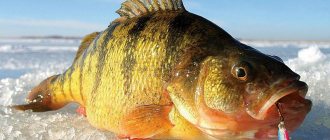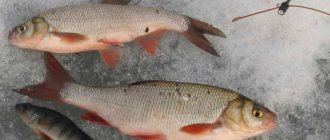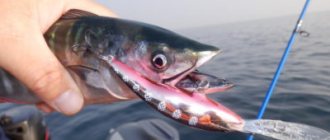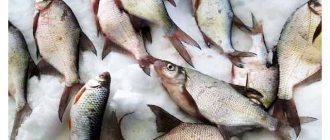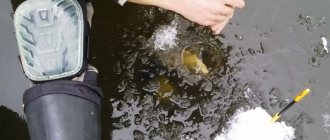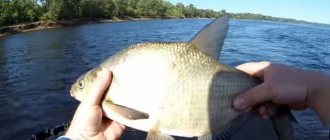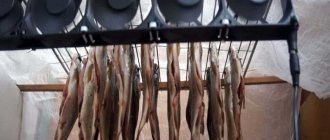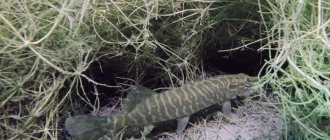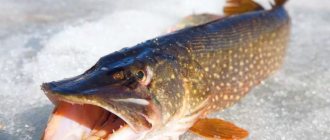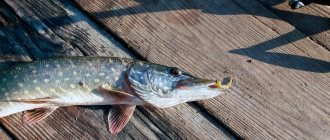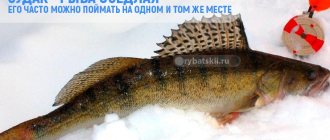How nice it can be to find a fishing spot on a pond where no one bothers you. And the fish bite like a machine gun, and you can concentrate only on fishing, without being distracted by your neighbors. But does this always work out? How to find these treasured places under a thick layer of ice? It’s good if you are going to a familiar body of water and already know what kind of fish you can catch. Then, most often, it is enough to walk through the places where they fished before. Sooner or later you will find it. But what if you had to find yourself on an unfamiliar body of water?
An echo sounder is an excellent assistant for a fisherman. But what if this device is not there?
Winter sportsmen have accumulated significant experience in quickly finding fish sites in various reservoirs. We will try to introduce you to some of the main provisions of this search.
You can determine which fish predominates in a given body of water, the predominant size of the fish, and its depth placement before going fishing. To do this, just talk to fishermen who have already visited this body of water, or find information in fishing magazines and the Internet. In this case, it is of great importance to determine the type of feeding to which fish of each species are attracted and reliably “stand up”. After this, you can begin to search for those characteristic places where this or that fish should stay.
Coastal profile. The first thing to pay attention to is the placement of shoreline vegetation and the profile of the shoreline. Any change in these factors most often indicates a change in the topography of the bottom of the reservoir. The presence of edges and holes perpendicular to the main channel of the reservoir, hillocks, always attracts fish, since in these places there are shelters for it, and food concentration most often occurs here (especially if there is at least a slight current). Therefore, such places are checked first.
A few examples
Very often you can see various depressions in the profile of the coastline (photo 1). This suggests that there is a stream outlet here. The deeper this depression, the stronger the flow of water flowing into the reservoir. In this case, it can be assumed that opposite the excavation at the bottom of the reservoir there is either a sand spit, which could have been formed due to the removal of soil by a stream, or in this place there is a hole that facilitates the sliding of soil from the shore.
Such places are especially promising during periods of sharp changes in atmospheric pressure: when growing, the fish “stands up” in deeper places, and when falling, on the contrary, it tends to rise to the upper edges, but will never move far from the feeding place.
A similar situation occurs with a sharp change in the coastal profile - a transition from a flat coast to a steep one. Most often this happens when there are deep holes opposite a steep bank and a shallow bank opposite a gently sloping bank. There is also a transverse edge that attracts fish. Only in this case it is necessary to take into account the presence of current. Most likely, the fish will concentrate at the entrance to the hole and to a lesser extent at the exit. Small gentle outcrops (most often in such places there is no vegetation) usually indicate the presence of a “beach”. In such places, even in winter it is quite difficult to find fish.
Orientation by external signs
Chub fishing in winter
Large, seasoned chub prefers to stay with the current in fairly deep places. Often it is caught along the way when fishing for bream, silver bream and roach. However, the handsome red-finned fish does not fish in pits, but on a gently sloping bottom, at depths from 1.5 to 6 meters.
The main difficulty when targeting chub in winter with a jig or fishing rod is to find a school of chub. Claims that this fish hibernates during the winter and leads a sedentary lifestyle have not come true in practice. I can say that the biggest catches last season were just during the deep winter, in February with temperatures far below -20 degrees.
Another feature of catching chub in winter on a river with a jig is its natural caution. After catching one or two fish, the rest of the school moves away from the hole and almost never returns. In summer, the chub is no less shy, but in the warm season it can be brought back with additional bait.
Vegetation orientation
Any coastal vegetation can also carry certain information about the topography of the bottom of the reservoir. It is known that each plant species occupies its own strictly defined niche. Thus, reeds and reeds grow in areas of the reservoir where there is practically no current, and occupy depths mainly up to 1.5 m. Water lilies can grow at depths of up to 3 m. Therefore, any change in the relief of coastal aquatic vegetation also indicates a change in the bottom topography.
Most often, in closed reservoirs, we encounter thickets of reeds. Moreover, the relief of coastal vegetation formed by reeds can be quite rugged (photo 2). Any depression in continuous thickets of reeds most often indicates the presence of some kind of hole opposite it or changes in the topography of the longitudinal underwater edge. Conversely, reed protrusions indicate the presence of underwater hills.
Vegetation on the ice surface will help you discover the treasured spot
In all these places there may be a concentration of food, which means there should be fish present. However, it should be borne in mind that these pits and mounds may not necessarily be located near reed beds. They are often located some distance from the coastline. In this case, they can be detected by drilling a series of holes perpendicular to the coastline, opposite the promising location.
Using the first, still transparent ice, you can also navigate through thickets of elodea or dying leaves of water lilies. Sometimes they can be seen through a mirror of ice, and sometimes these plants are frozen into the ice, where they can be found. If there are isolated bushes of vegetation, fish should be looked for in the immediate vicinity. In this case, the plants act as shelter. If algae cover the bottom with a continuous carpet, then, on the contrary, you need to look for fish in the windows above the clean bottom.
Similarities between winter fishing and summer fishing with spinning
Fishing in the winter months with a fishing rod is in many ways similar to summer fishing with a spinning rod. A constant active search for fish sites, when you have to navigate the coastal topography, the configuration of which will “tell” the necessary data about the depth of the reservoir in the selected area, about depth differences, and about the strength of the current. Another point reinforces the similarity between winter fishing with a rod and summer spinning fishing: if you were able to “attack” the underwater edge, then 50% of success is already in your pocket. Spinning fishermen know that pike perch passes along the edge; Fish also walk along it in winter, and a very high concentration of fish can be observed here.
In winter, fish usually bite on a fairly narrow (one and a half to two meters) strip, along the edge line. If you step to the left, you step to the right, and the bite is gone, so you can “break through” the summer fishing spots with a spinning rod in the winter. At the same time, the edges and depth differences discovered during the winter search for fish will be very useful in the summer when fishing with a spinning rod. You will have a clear idea of the bottom topography and the position of the edges in relation to the coastline. But regarding the same pike perch, it must be taken into account that in the summer it is more often at a depth of two to three meters behind the near edge, and in winter it moves to a depth of three to four meters, on the far edge.
Orientation on the ice surface
Deep eyebrows
Particular attention should be paid to cracks and faults in the ice. The presence of these factors most often indicates a change in the bottom topography in a direction parallel to the bed of the reservoir. Most often they occur when water levels fluctuate. This pattern can be traced both in standing reservoirs and in reservoirs with a current.
When going out to fish in large reservoirs, many saw large faults in the form of hummocks. They are located in places with a sharp change in the bottom topography. For example, on the Rybinsk Reservoir near the village of Milyushino there are usually two such faults. One is at a distance of a kilometer from the coast, where the depth difference occurs from 2 to 4 m. The second is at a distance of three to four kilometers with a depth difference from 4 to 6 m. Almost everyone knows about this and knows how to use these signs correctly.
But even small cracks, which can be detected only by looking closely, carry a lot of information about the reservoir.
Picture 1
The presence of edges, even with small differences in depth, running parallel to the main channel of the reservoir is especially well determined. This is due to the uneven growth of ice at different depths. When the load on the ice increases, such cracks appear. Moreover, these barely noticeable cracks can also be used to determine changes in their profile (Fig. 1). Such places most often attract fish. This sign works especially well on small lakes and ponds. Moreover, these cracks are visible not only on clean ice, but also on snow cover that has been compacted after a thaw.
How to find fish in an unfamiliar body of water in winter
→ Hunting and Fishing
Did you have the opportunity in winter to go fishing in a reservoir where the species diversity of the inhabitants is very high, and so is the quantity? Are you thinking of trying your luck in uncharted spaces, or going to a proven place? To avoid such disagreements, there are several proven tactics for behavior on an unfamiliar body of water. They will help you increase your catches.
The first thing you should pay attention to is, of course, the thickness of the ice. You shouldn’t run as fast as you can and “plunge headlong” into the unknown; safety comes first. After we are convinced that the ice is strong enough, we look around. If you arrive at the reservoir in the dark, you should follow the path exclusively. So, you are standing on the ice and wondering which way to go in search of the long-awaited bite. If the ice is not completely thick (up to 5 cm), then you should not go far from the shore at the beginning of fishing, since after 3-5 meters the ice can be much thinner. This occurs due to the presence of current. How do you know if there is a current or not? We drill the first hole and lower it into a small, fairly light jig on a thin fishing line and reach the bottom. We got to the bottom - very good. If the line does not deviate to the side, then there is no current at a given depth; we do the same in several holes, moving away from the shore.
The surest way not to be left without fish during the first ice is to actively search for schooling perch. It is not difficult to look for, as it is more common than any other fish. It can be:
- coastal capes with depths of 2-4 m;
- small bays throughout the water area;
- bunches of reeds sticking out of the ice;
- snags, fallen trees, stumps;
- underwater streamers, etc.
If there are no “attractions”, fishing should begin in the place where the current is weakest or absent (with the exception of large specimens at decent depths). We select the fishing depth as follows:
- or we drill a hole at the level of other anglers;
- or we measure the depth with a depth gauge (with a heavy jig or weight) and start fishing in the place where there is a significant difference in depth (from 0.3-0.5 meters).
We move from the shore into the depths. It is also worth observing the behavior of your neighbors. Since in winter the fish stay mainly in schools, it is better to move to a more successful angler. At the first bites, you should focus on the depth and try to stick to it. If the bites are over, then we take an ice screw in our hands and drill another hole at a distance of 2-4 meters; if there is no bite, we drill a hole in the opposite direction from the first hole. You can buy an ice screw in an online store, the main thing is to enter the search words correctly, for example, “Ice screws Barnaul” and select something from the options that appear. After all, the law on first ice is this: the more you drill, the more you catch, so you can’t do without a good tool.
No more bites? This means that the flock has moved a sufficient distance, and it should be noted that you should not return to these holes if you do not want to waste time. During the period of first ice, perch is very active and is in constant motion. So back on the search! You can use the “zigzag” method, moving in one direction, drilling holes equidistant from the straight line in both directions. This method is also good for finding pike perch during the day and burbot at night. A wide variety of wiring should be used; a combination of them should be used - these are the best provocations for perch.
A few more rules:
- if the weather is cloudy, then you should look for striped fish at the bottom (half a meter away);
- if it is sunny and clear, then look for it throughout the entire water column.
If you remember these techniques, then luck will definitely reward you with a good catch.
Published: 12/02/2012 Tags: Pond, Hole, Fish, Fishing, Catch
© Copying of material is permitted only with an active link to Readmas.ru
← Previous article Next article →
Add a comment Cancel reply
RELATED ARTICLES:
Features of pike fishing
African safari for outdoor enthusiasts
Successful fishing on trout lake
Preparing for the hunt
About types of hunting
Features of autumn fishing - how not to be left without a catch
Mongolian girl and eagle
Donkey fishing. Minimum Required
Why do you need to know this?
Firstly, fish usually linger in places where there is shelter from predators and food is available. They are characterized by changes in relief. Secondly, most often there can be several edges. The fish concentrate near them both along the lower and upper boundaries (Fig. 2). Experience shows that larger fish are located on deeper edges. On the flat areas between the edges, the so-called “tables”, the concentration of fish is much lower. It is not always possible to pull fish away from their favorite stopping places even with a large amount of feeding, especially in the dead of winter.
Figure 2
It is possible to more accurately determine the location of the edges, even with small differences in depth, running parallel to the main channel of the reservoir, by drilling holes perpendicular to the coastline and measuring the depths in them using a feeder or depth gauge.
However, it must be remembered that in these places the fish usually do not stand in one place. When disturbing factors appear (large crowds of fishermen), it begins to move along the edge to quieter places. Therefore, it is necessary to monitor nearby anglers. They will help you navigate in the direction the fish is moving.
Stand next to a group of fishermen for a few minutes. You may notice that the frequency of bites is different for everyone. The center of the fish school is where the bites are most frequent. Where it has already passed, there are only sporadic bites. Particular attention should be paid to anglers sitting separately at some distance from the “crowd”. As the fish moves, some will begin to bite. By comparing all this, the direction of movement of the fish school is determined.
By working ahead of the crowd, your catch will be significantly greater than if you tried to catch all the fish while you were among the anglers.
With more complex underwater edge relief, when fishing, you need to monitor not only your group of fishermen, but also neighboring groups. With intense pressure, the fish can actively move away from the edges. Most often this occurs in the spring. In this case, it is more profitable to look for fish in a free, not yet illuminated area between the groups.
Mounds and holes
Separate small shelters in the form of pinpoint holes or mounds in a pond also attract fish. The presence of snow mounds and depressions on the ice can also provide information about the presence of underwater irregularities. Obviously, this factor is associated with uneven cooling of water when its layer thickness changes. At the same time, the thickness of the ice cover increases unevenly.
In deeper places the ice thickness is always slightly less than in shallower ones. Young ice, working as a membrane, with increasing load on it (falling snow cover) has different deflections in different places. At the same time, even in small depressions that are invisible to the human eye, snow is retained better, and in the future a snow mound forms in this place. Often such changes can only be seen by bending low over the ice and looking into the distance.
Pits and mounds of ice will help you find a promising fishing spot
The appearance of snow mounds can be caused by another factor. Old holes, most often located in fish holding areas, contribute to snow retention. This may also indicate where fish are concentrated.
In shallow bodies of water overgrown with aquatic vegetation, uneven snow cover is caused by uneven ice formed by algae grown into the ice. At the same time, fish are most often concentrated in spots in such places. Depending on the predominance of a clean bottom or aquatic vegetation, the fish can be located either in the area of clean sandy spots (on heavily overgrown reservoirs), or near separate bushes of aquatic plants, where food lingers and there are shelters from predators.
You can check the correctness of the conclusions about changes in the bottom topography in the fishing area by measuring the depths using a depth gauge or echo sounder. In this case, it is possible to determine both the type of bottom and the presence of underwater vegetation: on a muddy bottom, the depth gauge sticks, on a sandy bottom this does not happen, and on a rocky bottom, hard impacts are felt. Plants will show themselves as depth gauge hooks.
All the examples of orientation discussed above relate mainly to bodies of water with standing water or weak currents. But you also have to fish on rivers.
Habitats.
Where to look for pike on the river in winter?
Depending on the winter fishing season, pike can stand and hunt in different places and at different depths. According to the first ice, it will be at shallow and medium depths, usually in the coastal zone, not far from reeds or snags. In the middle of winter, during the so-called low winter period, pike will stand along the edges of the riverbed or along the edges of wintering pits. Also, at any winter time, pike will be attracted to places with a heavily indented bottom, with frequent changes in depth, or places where the bottom is strewn with snags.
When looking for pike in winter, you should avoid places with a very muddy bottom. There will be especially few pike in such places during the deep winter period.
Where to look for perch on the river in winter?
You don’t have to look for perch at all; it lives in all places where you drill a hole. But such a perch usually does not suit fishermen. Every fisherman wants to catch bigger and bigger bass.
But you need to look for large-sized perch in holes and changes in depth; usually it lives at the very bottom and moves alone.
Where to look for pike perch on the river in winter?
In winter, it is customary to look for pike perch at depth, along channel edges, in holes, under dumps. But also, especially in spring, pike perch can move to places with a flat bottom, to medium depths.
Pike perch are especially attracted to holes at the bottom that are filled with snags.
Usually you can’t catch a lot of pike perch from one hole; you need to constantly look for the predator, so to speak, follow the flock.
Where to look for roach in winter?
In winter, depending on the winter fishing season, roach can be found both at shallow and medium depths, and at large ones.
On the first ice, roaches should be looked for in places near the reeds, in places that were overgrown with algae in the summer. But with the strengthening of frosts, the roach begins to gradually move to greater depths; at this time it can be in pits, on dumps, on riverbed tables.
And already during the period of the last ice, the roach again begins to move to shallower depths, to places where melt water falls under the ice, these are bays, places where streams flow. Also at this time it can be found at the snag.
Where to look for bream in winter?
Bream is a deep fish that should be looked for in holes, at sharp changes in depth, along the edges of these changes.
In winter, bream can often be found together with pike perch; it happens that they even move along a pond together.
In general, try to catch bream in pits in winter. Bream lives at the very bottom; slightly above the bottom there are smaller individuals, which we all call bream.
Orientation on bodies of water with current
The principles remain the same. You just need to remember that the fish can stay in other places. Let's try to figure this out too. Determination of water flows. In winter, when the water contains a small amount of oxygen and the fish are less active, each species tries to occupy its clearly defined place. Perch usually concentrate directly on the mouth areas of inflowing streams. Here the water is more saturated with oxygen, where the fry spin (Fig. 3). A medium-sized roach is nearby, but on the backflow of the stream. The larger one prefers deep areas where the current weakens. And bream usually concentrates in holes, located at a convenient depth. Moreover, even within one day, the level of location of a school of bream can vary greatly. The pike perch stays along the edge of the bream school near the bottom.
Figure 3
How to find these places on a body of water covered with ice? There are no problems identifying stream outlets. They are clearly visible along the coastline. The steep banks will tell you the boundaries of the holes. But you can try to determine the boundaries of current jets by characteristic features on the ice.
During the period of ice formation on rivers, quiet-water bays freeze first. Usually the channel part remains ice-free for a long time. At this time, slush ice is nailed to the edge of the already risen ice, and a ribbed boundary is formed, showing the course of the jet.
Where the stream of water weakens, the ice grows more evenly, and such pronounced irregularities as described above will no longer exist. But characteristic cracks appear in these places. There are similar cracks in the pits, not far from the underwater edges.
On rivers with currents, the distribution of fish food resources is further complicated by the presence of reverse currents in certain places. This is not reflected externally on the coastline or ice surface. However, you can try to identify them. To do this, you need to very carefully observe the bends of the coastline, imagining how the main water flow moves, where on the shore it hits and at what angle (Fig. 4). Usually in these places, due to various obstacles, a bifurcation of the flow occurs - a reverse flow appears. This is where rudd and large roach like to stay.
Figure 4
Finding shelters
Unlike stagnant bodies of water, in rivers large fish such as perch or roach, paradoxically as it may sound, are less mobile. Usually it occupies the most convenient and aft places, not allowing small items there. And at these points you can sometimes catch fish for a month from one hole. In the neighboring holes there will be only rare bites. Such places include flooded bushes, individual flooded logs, and any other shelter.
Finding flooded bushes close to the shore is quite easy, and you don't need to avoid them. But you often have to catch among the branches. It is somewhat more difficult to identify flooded bushes and logs located on the riverbed. Usually they are located on the border of the main stream and calm water. How to determine this boundary has already been discussed above. Inexperienced fishermen, having found themselves on such a flooded bush and torn off several jigs, usually leave it, depriving themselves of the pleasure of catching a “marketable fish”.
In this case, it is necessary to drill a hole upstream and select the weight of the jig so that it rolls under the bush. True, in such places you have to drill up to a dozen holes until you find a place where the jig falls under a bush, and there are practically no hooks. But the catch will justify the effort.
Finding a catchable spot is a guarantee of a good catch
Thus, even on regular fishing, you have to take into account many different factors in order to find that one catchy hole. Often you have to compare a large number of features. The head begins to work like a computer. But if you learn to use them, then finding catch points will happen automatically. Knowledge of the above-described features of searching for fish and the ability to quickly navigate a body of water will allow you to always have a good catch, even in the worst biting conditions.
Where to look for fish in the middle of winter?
At this time, underwater inhabitants prefer places with a hard bottom - clay-sand, pebbles, where there are a small number of aquatic plants and a barely noticeable current. At this time, the fish tries to avoid places heavily overgrown with vegetation, where the process of rotting of last year’s algae occurs, which draws out the last oxygen from the water and oxidizes the aquatic environment. These are usually places with standing water and muddy bottoms. Although such areas may be rich in food, you should not look for fish in January and February and hope for an active bite here.
On large reservoirs, the signs of deep winter are least visible. The amount of oxygen in a huge volume of water is enough for a long period. The fish continues to feed all winter, but becomes more capricious and bites cautiously. In the reservoir, unlike rivers, there are no winter parking areas as such - wintering pits. The fish are more evenly dispersed, but still prefer to go to feeding areas that are adjacent to the greatest depths. The temperature of the water at depth is several degrees higher, and it is more comfortable for her to relax and slowly digest her food.
Sand spits with a clear difference in depth and small bushes and snags at the bottom, outlets into bays overgrown with algae, navels adjacent to deep holes are promising places to search.
In rivers, peaceful fish accumulate in huge schools in wintering pits - unique deep places with hard soil and weak currents that form behind water obstacles - mounds, rocks and others. Often in such places, or nearby, there are abundant colonies of shells on the bottom - food for bream, ide and carp. There are few such places in the river. Not every deep hole will be a wintering hole. Fish need several favorable factors for winter “parking”.
Schools of large fish usually accumulate in wintering pits. There may not be room for small items. Small fish are less demanding on wintering conditions. Therefore, roach, dace, perch, etc. are dispersed throughout the river. It can be found in local holes near coastal bushes, in bays where the current slows down and a “return” is formed. In holes next to grass and snags, protected from the current. Right there, next door, a predator is always watching over them.
Large bream and ide can be successfully caught using a combine harvester or winter passes in such places; read the article about this: “Fishing with a combine harvester. Large bream and ide from the ice"
